|
|
Gibside Fairy

|
|
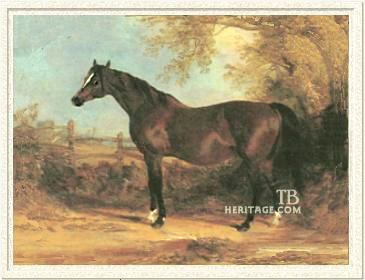 |
|
|
Gibside Fairy was one of the stellar matrons of the British turf, having produced four daughters from whom most of Family 7 descends. All four were by Derby winner Whisker, making the Gibside Fairy - Whisker cross one of the most influential pairings in the thoroughbred breed. She was bred in the Streatlam Stud, County Durham, belonging to the John Bowes, (10th) Earl of Strathmore, where the Byerley Turk mare that heads Family 3, was trained over one hundred years prior to Gibside Fairy's birth.
Gibside Fairy's dam, the in-bred Vicissitude (1800, by Pipator, out of Beatrice by Sir Peter), had been sold, along with her dam, by their breeder, William Fenwick, of Bywell, Northumberland. When her owner did not pay the expense of keeping her at the Streatlam Castle paddocks stud, the Earl took Vicissitude and Beatrice in payment.
|
| Gibside Fairy's Produce Record |
| Year |
Foal |
Sire |
| 1816 |
Woodlark ro.c. |
Remembrancer |
| 1817 |
Unnamed ro. f. |
Remembrancer |
| 1820 |
Elf b.c. |
Comus |
| 1823 |
Fairy b.f. |
Magistrate |
| 1824 |
Emma ch.f. |
Whisker |
| 1826 |
Unnamed b.f. |
Tramp |
| 1827 |
Maria b.f. |
Whisker |
| 1828 |
Unnamed b.f. |
Whisker |
| 1829 |
Unnamed b.c. |
Whisker |
| 1831 |
Maid of Lune ch.f. |
Whisker |
| 1833 |
The Cauld Lad of Hilton b.c. |
Whisker |
| 1836 |
Streatlam Sprite b.f. |
Physician |
| 1837 |
The Wizard of Wemmergill br.c. |
Curtius |

Gibside Fairy with Streatlam Sprite | |
Pipator, a great-grandson of Matchem, had three different lines to Croft's Partner, and two to Herod. He was a product of the Norfolk stud of William Henry Fortescue, the Earl of Clermont, who had bred his sire, Imperator, and purchased his dam, Brunette. Brunette produced a series of good runners to the cover of Conductor first, and then Imperator, including Trumpator (1782, by Conductor), who became a leading sire in 1803, sire of Sorcerer and the great broodmare Penelope, among others.
Pipator (1786), by the short-lived Imperator, ran in top company at Newmarket, his best race probably a four mile, 1500 guineas purse in which he ran second to Skyscraper, beating fourteen others in 1791. He was purchased by John Bowes, (10th) Earl Strathmore from the Earl of Clermont after his racing days were over, and stood first at Esher (near Kingston), Surrey, later moved to the Streatlam paddocks of Strathmore's in County Durham.
Pipator sired Remembrancer for Strathmore, from the 14.3 hand chestnut mare Queen Mab (by Eclipse) the Earl had purchased for £296, unraced. Remembrancer won the St. Leger in 1803, the Doncaster Cup, the Newcastle Gold Cup (twice), and the York Gold Cup. He stood at Streatlam for 8 guineas, and then was moved to the Malt Shoven Inn at Boroughbridge, where he stood for 10 guineas.
|
The Sir Peter daughter, Beatrice, was bred by William Fenwick, of Bywell, Northumberland, an important breeder and scion of a family long involved in breeding and racing horses in the north. Beatrice's sister, a mare by Herod (1780) was the dam of the St. Leger winner and sire Beningbrough (1791). Beatrice was sold, in foal to Pipator, and her filly, Vicissitude (in-bred 4 x 3 to Matchem) was dropped at the Streatlam stud in 1800; when the expenses of keeping her went unpaid by her new owner, and eventually exceeded that of her worth, the Earl of Strathmore took her and the filly in lieu of payment. Beatrice would breed twelve additional foals for Strathmore, including the good runners Runnemede (1806, by Coriander) and Heart of Oak (1811, by Remembrancer).
Hermes (1790) was a lesser light on the turf, his sire Mercury (by Eclipse), a good four-mile horse owned by the Earl of Egremont, who bred Hermes from a Woodpecker daughter, Rosina. Mercury had proven a good sire who got Oaks winners Hippolyta and Platina and the handsome and successful runner and sire, Gohanna. Hermes went blind from an inflammation when racing in Winchester, and was sold to Strathmore, later used both as a hack and a driving horse by the Earl. He was used sparingly as a stallion, and serviced mares for 15 guineas, including a number of half-breds, producing some excellent trotting horses. When he died, he was buried at Strathmore's Gibside estate (40 miles from Streatlam in the Derwent River Valley), as were Pipator and Queen Mab.
Vicissitude produced eight foals, with nine barren years, slipping twice, and died in 1827. Her only foal to have a lasting impact was her Hermes daughter, Gibside Fairy, a red-bay filly born in 1811. Gibside Fairy's only start was the Yearling Stakes at Catterick Bridge as a juvenile, which she won, beating three colts.
Retired to the Streatlam stud, she was bred to Remembrancer in 1815, and dropped a colt, Woodlark, the following year, and a filly by Remembrancer in 1917. She produced youngsters to other stallions, including Comus, Magistrate, Tramp and Physician up to 1837, after which she was barren, but her best were all fillies by Derby winner Whisker, one of the first really good southern horses to stand at stud in the north of England. Whisker got two St. Leger winners and some long-running, successful colts and fillies. As it turned out, he was an exremely successful broodmare sire, even discounting the daughters of Gibside Fairy.
The Earl died in 1820, leaving his estates to his young, illegitimate son, John Bowes (born 1811), to be managed by trustees until young John reached his majority. So the Streatlam stud was managed throughout the 1820s by the estate's trustees, and primarily by the owner of Whisker, William Henry Vane, then Earl of Darlington (later 1st Duke of Cleveland), at nearby Raby Castle. Thus, Gibside Fairy was put to Whisker every year but one between 1823 and 1833, and it was in this period that she produced four daughters that became influential broodmares: Emma (1824, Family 7 - a), Maria (1827, Family 7 - a), Caroline (1828, Family 7 - b), and Maid of Lune (1831, Family 7 - c).
|
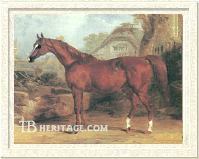
Emma | | EMMA (1824) was "long and low," 15.1-1/2 hands tall, with less bone than her dam. She was bred by the Earl's trustees, and later sold, or more likely leased, by coal magnate and banker William Russell who, in 1796, had purchased Brancepeth Castle, about four miles south of Durham. Retired to the Streatlam stud, she produced seventeen foals, including two Derby winners -- Mundig and Cotherstone --Trustee, an influential sire in America, and Mowerina, the dam of English Triple Crown winner West Australian and other good winners.
|
In her latter years she was "a bag of bones, and shocking bad she looked." She died at age twenty-eight, in October, 1852, having "taken her mash as usual" the night before, she was found in the morning by long-time Streatlam stud groom Isaac Walker, "...stretched out and cold, with her head resting on the threshold."
Emma ran for two years, and if not top-class, was still a pretty good juvenile. She won three of her four outings as a juvenile, a 500 sovereign match against Sharpshooter at Doncaster; 160 guineas at Richmond, beating Nonplus and five others; 180 sovereigns at Northallerton, beating eight other youngsters. She ran second to Moonshine in her other race, Doncaster's Champagne Stakes, which was her debut race. At age three she placed in four of her six races: she was second to another Whisker daughter, Lunaria, in the Old Stakes (for three year olds) at Catterick, in a field of six; second again to Lunaria in a sweep for three year old fillies at Catterick; third of four runners in the Newcastle Cup; third in Doncaster's Gascoigne Stakes to Granby and Cannon Ball, beating three others, including a Warwick Gold Cup winner. She failed to place in the Doncaster St. Leger and in her final race of the season, a 260 sovereign sweep, the latter won by Lunaria.
At Streatlam she produced her first foal, the chestnut Trustee, by Catton, in 1829. Trustee was a high-class stakes horse, sold to America at the end of his racing career, in 1835. He was imported by Commodore Robert Stockton of Princeton, New Jersey. In America, Trustee got the great race mare Fashion (1837, from Bonnets o'Blue) for Stockton in his first season at stud, after which Trustee was sold on to Walter Livingston of New York and stood at stud in Long Island until 1841, when he was sent to Virginia, then Kentucky, and back to Virginia, before being sent back to New York, where he stood in Westchester County until dying in 1856 at the age of twenty-seven. In addition to Fashion, and other good runners, he got Revenue (1843, in Virginia), who led the sire's list there in 1860, sire of Planet, himself later a good sire, and Levity (1845, in Kentucky), one of the most influential mares in the American stud book (Family 12 - b). |
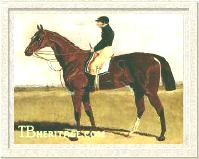
Emma's son, Mundig
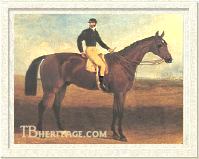
Emma's other Derby-winning son, Cotherstone | | Mundig, a brother to Trustee, was born in 1832, was Emma's biggest foal, and grew to be a big and somewhat coarse colt with "fine and sweeping" action when running. He was placed in training with John Scott, the "wizard of the North," who trained all of Bowes' horses until his death in 1871. Mundig's name in German means "of age," which was particularly suitable, since his young owner, John Bowes, reached his majority at age 21 just before Mundig's first appearance on the turf in the Epsom Derby. The story is told that Bowes' trustees had wagered large amounts on Mundig in the months prior to word getting out regarding his ability in training, and Bowes, realizing this, threatened to pull the horse from the race, now that he was of age, unless the wagers were transferred to him, who had not been privy to the knowledge; the transfer of bets was soon forthcoming, with the trustees scrambling to bet again with much lower odds, before the race. Bowes won a great deal of money(reportedly £20,000, roughly equivalent to over 1 million dollars today) on Mundig in the Derby, which Mundig, ridden by Scott's brother, William Scott, won by half a neck in a field of thirteen, beating Ascot, after a duel in the final stretch. He did not race again until Doncaster, where he failed to place in the St. Leger, but he won the Foal Stakes there the next day, beating three other youngsters.
|
At age four he won two of his six starts, the King's Guineas at York, beating Wentworth (winner of the Corporation Plate at Newcastle) and five others, and the King's Guineas at Nottingham. He ran second to Venison in the King's Guineas at Doncaster, and was unplaced in the Liverpool Cup (won by Birdlime), the Stand Cup (won by General Chasse), and was fifth and last in the Heaton Park Gold Cup. Despite his Derby win, Mundig was only a fair racer, and an unimpressive sire in England, and was sold to Prussia in 1843, where he got some foals at the Trakehnen Stud.
The bay Cotherstone, born in 1840, was by the great sire Touchstone, and was Bowes' and Emma's second Derby winner and was Emma's best runner; he also won the Two Thousand Guineas, and was narrowly beaten in the St. Leger. He was a "thin-fleshed" yearling, and had a series of problems at age two, "always amiss." Also trained by John Scott, he was started at age two, running unplaced in the Criterion at Newmarket Houghton and, at the same meeting, dead-heating with the filly Mania in the Nursery Stakes.
At age three he started at Newmarket Craven, winning the Riddlesworth Stakes, beating Pompey and Elixir, both by Emilius, and at the same meeting, the Column Stakes, beating four others, including the One Thousand Guineas winner Extempore. He went on to Newmarket First Spring, winning the Two Thousand Guineas, and then, at Epsom, the Derby in an easy two length victory over a huge field of twenty-three. Bowes and his friends made a great deal of money backing Cotherstone early for the Derby. At Goodwood he beat Khorassan and others by two lengths in the Gratwick Stakes. Lacking his usual jockey, Bill Scott, who had been injured, Cotherstone met his first defeat of the season in the St. Leger, beaten by a head by Nutwith, but at the same meeting won the Three Year Old Stakes, beating two others. Back at Newmarket he won the Royal Stakes. In 1844 he was sold Lord Spencer for £3,000, and starting at Goodwood, he broke down running in a sweep there, which ended his career. He was retired to Spencer's stud at Althorp. He got a good running son in Stilton who won Great Metropolitan, but was better as a broodmare sire, with Pandora the dam of St. Leger winner St. Albans (also winner of the Great Metropolitan Stakes, the Chester Cup, and the Newmarket Stakes, and later sire of Springfield), and some other daughters that bred on.
Emma's daughter Mowerina (1843, by Touchstone), had a beautiful head with clean jowls and a long, laid-back shoulder, but was a bit light below the knees. She ran second to Mendicant in the One Thousand Guineas, but could only run fifth in the Oaks, which featured a top-class field of fillies. In the Streatlam stud, Mowerina produced the first English Triple Crown Winner, West Australian, for Bowes, and six other stakes winners, including West Australian's sister, Victorian, who won the Yorkshire Oaks and placed third to Mincepie in the Epsom Oaks; Nassau Stakes winner Go-Ahead (1855, by Melbourne), and Ebor Handicap winner Westwick (1863, by Stockwell). A great many winners descend from Mowerina and her daughters, including the Derby and St. Leger winner Donovan (1886) and his half-sister, One Thousand Guineas winner Semolina (1887), offspring of her great-grandaughter and namesake, Mowerina (by Scottish Chief).
Emma produced a total of seventeen foals between 1829 (Trustee) and 1848 (Ipsus, by Epirus). Of her other youngsters, her daughter, Jennala (1844), by Touchstone, produced the Verulam filly, Gruyere, that became the dam of Ascot Gold Vase winner and good sire Parmesan (1857, by Sweetmeat). Another of Emma's daughters, The Ladye of Silverkeld Well (1839), by Velocipede, had a Touchstone daughter, Touch-Me-Not, dam of Royal Hunt Cup winner Forbidden Fruit (1853), and a daughter by Orlando, Selina (1851), tail-female ancestress of a number of good winners to the present. Another Touchstone daughter, As You Like It (1842) produced the 1856 filly Audrey (by Stockwell), winner of the Cesarewitch Stakes. Her son, Black Beck (1837, by Mulatto), ran for John Bowes in the north, primarily plates, and later was sold to Hungary.
MARIA (1827) was bred by the Earl's trustees, and ran in the name of William Harry Vane, who was created Marquis of Cleveland the year she was born. She was the best runner of Gibside Fairy's good daughters, winning a number of races, including the York Gold Cup and the Great Subscription Purse at York in 1831, the King's Plate at Lincoln, and a Silver Tureen and the King's Plate at York in 1832.
As a broodmare, Maria was lodged at, if not in the possession of, Thomas Thornhill of Riddlesworth, Norfolk, the owner of the great stallion, Emilius, who is credited with breeding six of her eleven live foals, every single one by Emilius, and a good "nick" it was. Their offspring included Euclid (1836), winner of the St. James's Palace Stakes, the Grand Duke Michael Stakes, and second to Charles XII, after a run-off, in the Doncaster St. Leger. Euclid, who died fairly young, left behind a daughter, Eulogy (1843, from Martha Lynn, Family 2 - h), an excellent producer, dam of some great running daughters, all of which established strong female lines: One Thousand Guineas and St. Leger winner Imperiuse (1854); Cambridgeshire Stakes winner Eurydice (1855); Park Hill Stakes winner Imperatrice (1859), Clemence (1865) who was second dam of Le Samaritain. Euclid also got a son, Bantam, who sired, in Ireland, Zouave, a winner over fences and later a successful steeplechase sire whose sons included Grand National winner The Lamb.
Other Maria-Emilius offspring were: Theon (1837, by Emilius), owned by Cleveland, who won some races at ages two and three and later was used as a hunter sire at Raby. Maria's daughter Extempore (1840, by Emilius), who won the One Thousand Guineas for Thornhill and was later, through her daughter Jeu d'Esprit, second dam of Epsom and Yorkshire Oaks winner Feu de Joie (1859, by Longbow) and tail-female ancestress of a host of good winners, such as English Triple Crown winner Flying Fox. Extempore's sister, Equation (1838), produced Two Thousand Guineas winner Diophantes (1858, by Orlando). Maria's son Mathematician (1844, by Emilius), was sold to ex-pugilist, gambler and sporting man John Gully, for whom he won the Great Ebor Handicap. Mathematician was later broodmare sire of Cesarewitch Stakes winner Lecturer, later a good sire.
CAROLINE (1828), bred by the Earl's trustees, had a brief career on the northern turf as a juvenile, after being sold to the Marquis of Queensbury. She produced a number of daughters that bred on, forming the the branch of Family 7 - b that she heads. Many tail-female descendants won races in Germany, Austria, and Hungary. Derby winner My Love (1945) and Oaks winner Lovely Rosa (1933) descend from her via her daughter, Lady Emily (1842, by Muley Moloch). |
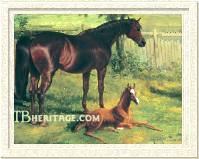
Maid of Lune | |
The liver chestnut MAID OF LUNE (1831) was one of the first horses to run, in York, in the colors of John Bowes after he reached his majority. Retired to stud in 1835, her first foal was Mickleton Maid (1836), by the good two-miler Velocipede. Mickleton Maid won Doncaster's Park Hill Stakes, the Warwick Cup, and five other races, and was third to Lanercost in the Cambridgeshire. She went on to produce some daughters whose descendants were successful and numerous enough to propel Maid of Lune to head her own branch of Family 7 (Family 7 - c), including some English classic winners and a great many successful horses in Japan. |
Another daughter of Maid of Lune, Heather Bell (1842, by Bay Middleton), was dam of Gimcrack Stakes winner JohnnyArmstrong and, through her daughters, an important tail-female ancestress of top winners in South Africa. Maid of Lune remained in the Streatlam stud until her death in 1853, having produced fifteen foals for Bowes.
Gibside Fairy's 1828 unnamed daughter by Whisker ran as a juvenile in the north for the Marquis of Queensbury. In the stud she produced seven unnamed youngsters and a colt, Billy (1836), by Brutandorf; this line did not continue. Streatlam Sprite (1836), by Physician, bred six live foals up through 1845, then a dead colt, followed by two barren years, after which she was "given away" and vanished from the stud book. Her last live filly, Jenny Lind (1845, by Magnet) won the coveted Paisley Bells at St. James Park twice. Gibside Fairy's unnamed Remembrancer daughter (1817) had offspring that bred on for a few generations.
--Patricia Erigero
|
|
|
|

